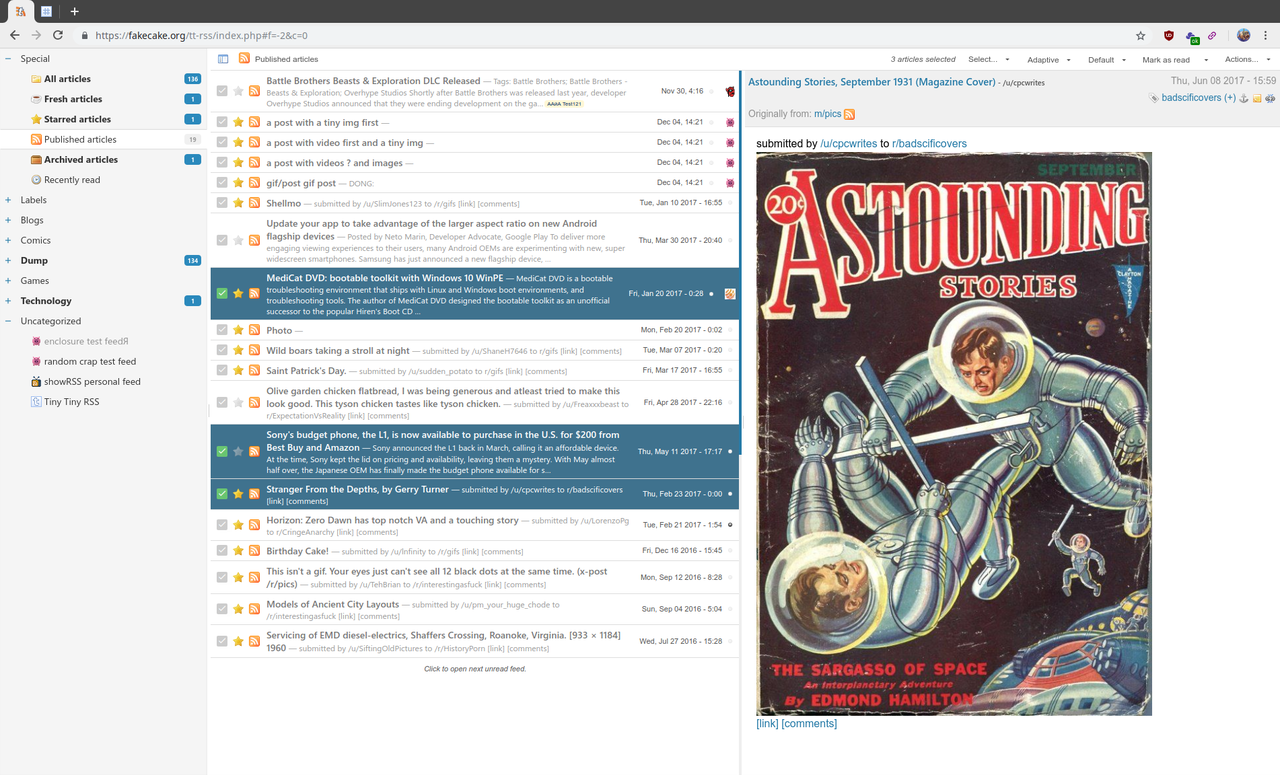This Docker image allows you to run the Tiny Tiny RSS feed reader. Keep your feed history to yourself and access your RSS and atom feeds from everywhere. You can access it through an easy to use webinterface on your desktop, your mobile browser or using one of the available apps.
Check https://hub.docker.com/r/fischerman/docker-ttrss/tags for different version. latest will be updated without further notice.
From the official readme:
Tiny Tiny RSS is an open source web-based news feed (RSS/Atom) reader and aggregator, designed to allow you to read news from any location, while feeling as close to a real desktop application as possible.
This section assumes you want to get started quickly, the following sections explain the steps in more detail. So let's start.
Just start up a new database container:
$ docker run -d --name ttrssdb nornagon/postgresAnd because this docker image is available on Docker Hub, using it is as simple as launching this Tiny Tiny RSS installation linked to your fresh database:
$ docker run -d --link ttrssdb:db -p 80:80 fischerman/docker-ttrssRunning this command for the first time will download the image automatically.
The above example exposes the Tiny Tiny RSS webinterface on port 80, so that you can browse to:
The default login credentials are:
- Username: admin
- Password: password
You're recommended to change these as soon as possible.
Having trouble getting the above to run? This is the detailed installation walkthrough. If you've already followed the quickstart guide and everything works, you can skip this part.
This container requires a PostgreSQL or MySQL database instance.
Following docker's best practices, this container does not contain its own database, but instead expects you to supply a running instance. While slightly more complicated at first, this gives your more freedom as to which database instance and configuration you're relying on. Also, this makes this container quite disposable, as it doesn't store any sensitive information at all.
The recommended way to run this container is by linking it to a PostgreSQL database instance. You're free to pick (or build) any PostgreSQL container, as long as it exposes its database port (5432) to the outside.
Example with nornagon/postgres:
$ docker run -d --name=tinydatabase nornagon/postgres:latestThe image nornagon/postgres exposes a database superuser that this image uses to automatically create its user and database, so you don't have to setup your database credentials here.
Use the following database options when running the container:
--link tinydatabase:db
If you'd like to use ttrss with a mysql database backend, simply link it to a mysql container instead. You're free to pick (or build) any MySQL container, as long as it exposes its database port (3306) to the outside.
Example with sameersbn/mysql:
$ docker run -d --name=tinydatabase -e DB_USER=ttrss -e DB_PASS=ttrss -e DB_NAME=ttrss sameersbn/mysql:latestThe image sameersbn/mysql does not expose a database superuser, so you have to explicitly pass the database credentials here.
Use the following database options when running the container:
--link tinydatabase:db
If you already have a PostgreSQL or MySQL server around off docker you also can go with that. Instead of linking docker containers you need to provide database hostname and port like so:
-e DB_HOST=172.17.42.1
-e DB_PORT=3306
Whenever your run ttrss, it will check your database setup. It assumes the following default configuration, which can be changed by passing the following additional arguments:
-e DB_NAME=ttrss
-e DB_USER=ttrss
-e DB_PASS=ttrss
If your database is exposed on a non-standard port you also need to provide DB_TYPE set to either "pgsql" or "mysql".
-e DB_TYPE=pgsql
-e DB_TYPE=mysql
When you run ttrss, it will check your database setup. If it can not connect using the above configuration, it will automatically try to create a new database and user.
For this to work, it will need a superuser account that is permitted to create a new database and user. It assumes the following default configuration, which can be changed by passing the following additional arguments:
-e DB_ENV_USER=docker
-e DB_ENV_PASS=docker
The SELF_URL_PATH config value should be set to the URL where this TinyTinyRSS
will be accessible at. Setting it correctly will enable PUSH support and make
the browser integration work. Default value: http://localhost.
For more information check out the official documentation.
-e SELF_URL_PATH=https://example.org/ttrss
This container supports internal and ldap by setting AUTH_METHOD to internal or ldap. Default is internal.
-e AUTH_METHOD=internal
If AUTH_METHOD is set to ldap you must/can set the following variables:
LDAP_AUTH_SERVER_URI. Default isldap://ldapLDAP_AUTH_USETLS. Default isFALSELDAP_AUTH_ALLOW_UNTRUSTED_CERT. Default isTRUELDAP_AUTH_BASEDN. RequireLDAP_AUTH_ANONYMOUSBEFOREBIND. DefaultFALSELDAP_AUTH_SEARCHFILTER.???is replaced by the login name. Default(&(objectClass=user)(sAMAccountName=???))LDAP_AUTH_BINDDN. RequiredLDAP_AUTH_BINDPW. RequiredLDAP_AUTH_LOGIN_ATTRIB. Default issAMAccountNameLDAP_AUTH_LOG_ATTEMPTS. Default isFALSELDAP_AUTH_DEBUG. Default isFALSE
For more information consult https://github.com/hydrian/TTRSS-Auth-LDAP
For testing purposes it's recommended to initially start this container in foreground. This is particular useful for your initial database setup, as errors get reported to the console and further execution will halt.
$ docker run -it --link tinydatabase:db -p 80:80 fischerman/docker-ttrssOnce you've confirmed everything works in the foreground, you can start your container
in the background by replacing the -it argument with -d (daemonize).
Remaining arguments can be passed just like before, the following is the recommended
minimum:
$ docker run -d --link tinydatabase:db -p 80:80 fischerman/docker-ttrss